

The New York Times And Its Faustian Facebook Pact. Editor’s note: Tom Goodwin is senior vice president of strategy and innovation at Havas Media.
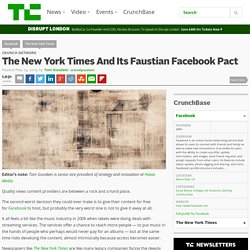
Notifications Are The Next Platform. Editor’s note: Anish Acharya is the co-founder and CEO of Snowball.
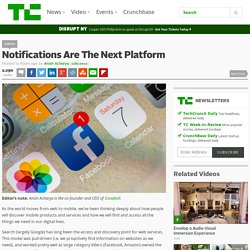
As the world moves from web to mobile, we’ve been thinking deeply about how people will discover mobile products and services and how we will find and access all the things we need in our digital lives. Search (largely Google) has long been the access and discovery point for web services. This model was pull-driven (i.e. we proactively find information on websites as we need), and worked pretty well as large category killers (Facebook, Amazon) owned the lion’s share of traffic (and revenue). Google was happily profitable owning the distribution channel. The mobile world started out as a pull-driven model — discovery and access was/is largely driven by a combination of the app store and the “grid of apps.” How Did Amazon End Up as Literary Enemy No. 1? Watch: How Adobe Illustrator Changed Graphic Design. In the pre-Adobe Illustrator age, graphic design was a tedious, meticulous analog process: it could take a day to set one page of type, and then maybe a temperamental Rapidograph pen would explode ink all over the page.

Physically cutting and pasting required actual scissors instead of just hitting ctrl-X and ctrl-V. With the launch of Adobe Illustrator in 1987, “it was like magic,” as designer Ron Chan puts it. In this mini-documentary by Terry Hemphill that tells the story of the revolutionary software, designers like Jessica Hische, Ron Chan, Bert Monroy, and Dylan Roscover, as well as Adobe co-founder John Warnock, recount the pivotal moment when computers became indispensable design tools. Google Wallet Gets Gift Cards, Request and Send Money. Google today updated its Google Wallet app for Android and iOS with new features, including gift cards, requesting money, sending money, and Spanish support. You can download the new version now directly from Google Play and Apple’s App Store.
First off, in addition to support for loyalty cards and offers, the app now lets you manage your gift cards and redeem them in stores. Airbnb CEO spells out the end game for the sharing economy, in 7 quotes. Elon Musk at TED about Tesla, SpaceX and Solar City. The 10 best designs for the Moto 360 watch face. Find out if Google's driverless car is legal in your state. Book publishers now make more revenue from online sales than from brick-and-mortar stores. A new report by BookStats finds that trade (consumer) ebook revenue in the U.S. was roughly flat between 2012 and 2013, even as the number of ebooks sold rose by 10.1 percent to an estimated 512.70 million.
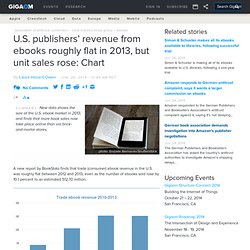
With more ebooks being sold, the seemingly contradictory 0.7 percent drop in revenue suggests they’re being sold at lower prices. BookStats also estimates that book publishers now make more revenue from online sales (of both print and digital books) than from brick-and-mortar stores, with $7.54 billion coming from online sales and $7.12 billion coming from physical stores in 2013. Messaging 2.0 Is Now Over. The second messaging revolution is now quickly coming to a close.
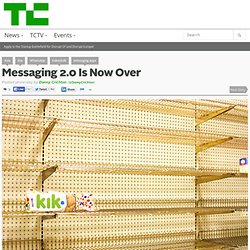
With the news today that Korea’s leading messenger KakaoTalk is merging with one of that country’s largest internet portals, Daum Communications, we are witnessing the end of the rise of mobile-focused independent messaging startups that started just five years ago. From pixels to polygons: 2D characters get three-dimensional. The Era Of Good-Enough Smartphones. The U.S. smartphone market remains quite peculiar.

Despite a plethora of inexpensive models from other companies, Apple and Samsung remain the dominant manufacturers that collectively take about 68 percent of the market and whose iPhones and Galaxies are among the most expensive options available. And they aren’t just getting affluent consumers to purchase them. As NPD Group data shows from 2013, iPhone sales grew 64 percent among consumers with incomes below $30,000. One reason for this sales growth is that both companies have provided consumers with more affordable options, either by introducing new models or cutting prices on existing ones. Apple continues to sell the iPhone 4S, which today is $450 unlocked. Top music subscrtion at May 2014. Chrome Most Used While Firefox Falls Below Safari and IE. Social discovery and sharing platform Shareaholic today updated its browser share report, showing how the market has changed in the last eight months.
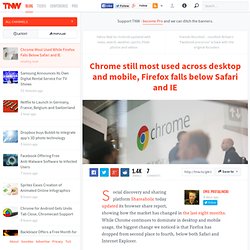
While Chrome continues to dominate in desktop and mobile usage, the biggest change we noticed is that Firefox has dropped from second place to fourth, below both Safari and Internet Explorer. Between the two reports, Chrome’s usage has remained flat, losing just 0.03 percentage points. As a result, it is still used more than Firefox, IE, and Opera combined. Firefox meanwhile lost 4.66 percentage points, Safari slipped 0.96 percentage points, and IE fell 3.13 percentage points. Here are Shareaholic’s three biggest takeaways from the results: The Safari (in-app) browser and the stock Android browser were the only ones with meaningful growth.
The first point reminds us just how important mobile is in the browser market. Supply chained: Apple's sapphire production will be hard to copy. Though abundant in nature and everyday items like soda cans, aluminum didn’t figure prominently in modern electronics until just a few years ago.

Then Steve Jobs discovered an appreciation for the metal, the unibody MacBook was born, and a chain reaction was set off that finds us now able to buy precision-milled aluminum hard drives, batteries, and even cameras. How did all this come to be? And is Apple about to repeat the feat with its latest investment in manufacturing, this time focused on sapphire glass?